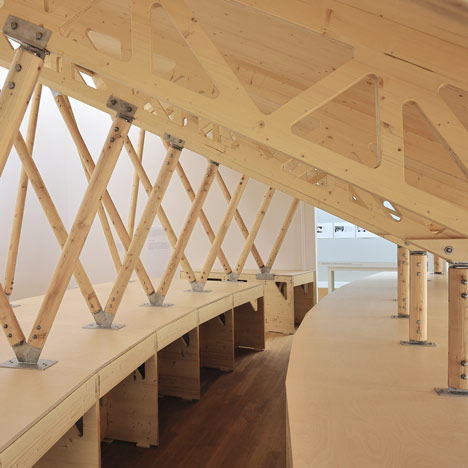
Venice Architecture Biennale 2010: a wooden 1:10 scale model representing a portion of the London 2012 Olympic stadium has been installed at the British Pavilion directed by muf architecture/art for the Venice Architecture Biennale.
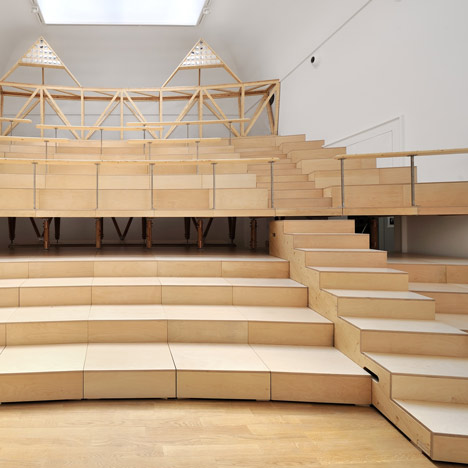
Called the Stadium of Close Looking, the structure is to host drawing workshops and discussions for biennale visitors and local schools.
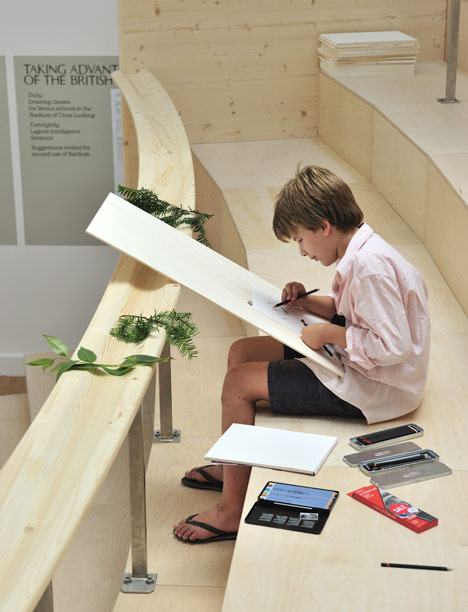
It forms the centrepiece of this year’s British Pavilion, entitled Villa Frankenstein, which focuses on Britain’s historical fascination with Venice and the obsessive documentation of the city by Victorian social critic and historian John Ruskin.
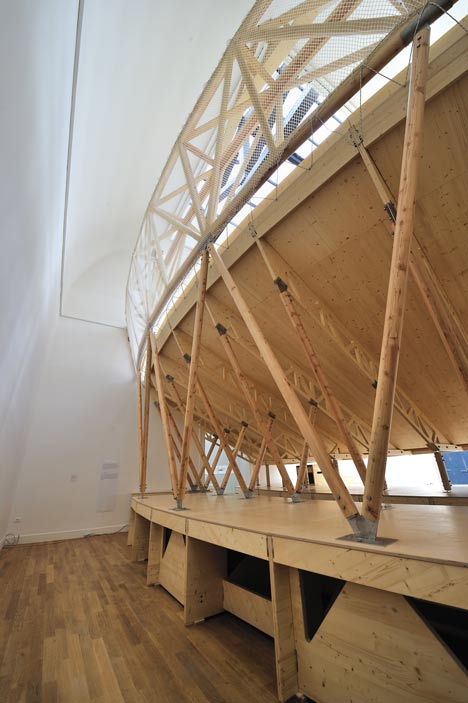
Ruskin’s drawings and seven notebooks from 1849-50 are displayed alongside photographs taken in the late twentieth century by local residents Alvio and Gabriella Gavagnin.
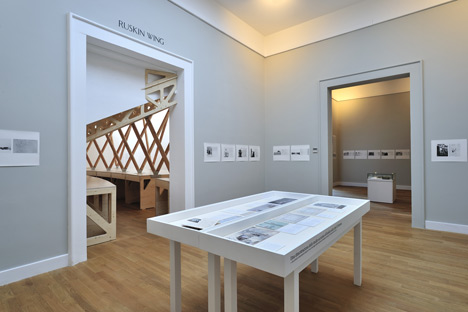
Exhibits were produced in Venice with only Ruskin’s notebooks brought from Britain. The Stadium of Close Looking will be reconstructed elsewhere in the city following the biennale’s end.
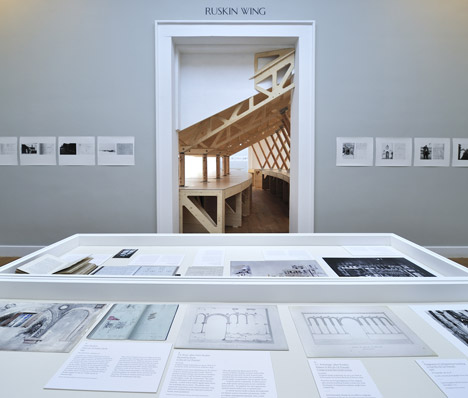
The Venice Architecture Biennale opens 29 August – 21 November 2010.
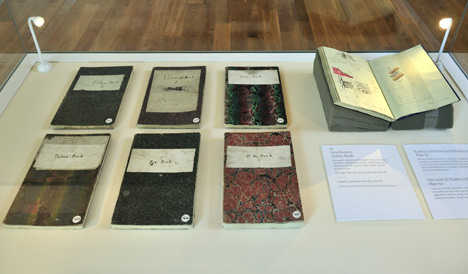
Photographs are copyright Cristiano Corte.
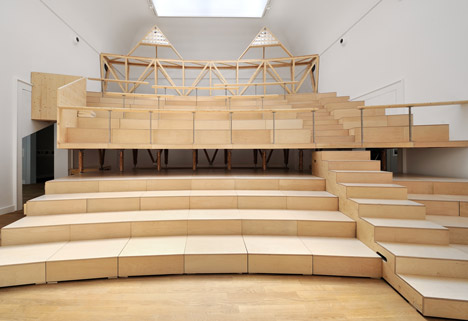
Here’s some more information from the British Council:
BRITISH PAVILION OPENS AT THE 12th INTERNATIONAL ARCHITECTURE EXHIBITION, VENICE
The British Pavilion at the 12th International Architecture Exhibition in Venice, commissioned by Vicky Richardson, Director of Architecture, Design, Fashion at the British Council – the UK’s leading educational and cultural relations organisation – and under the direction of muf architecture/art Llp, opens to the public on Sunday 29 August 2010.
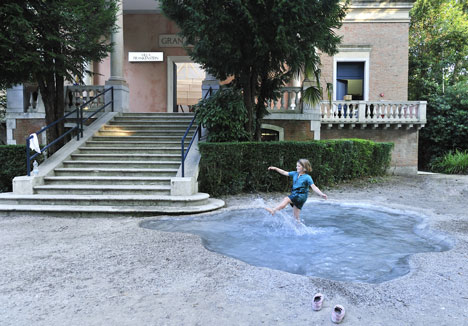
The Pavilion is ironically reframed Villa Frankenstein, making direct reference to the ideas of the British Victorian social critic and historian of Venetian architecture John Ruskin. It has been conceived by muf as a stage for an exchange of ideas between Venice and the UK. The centrepiece of the Pavilion, represented as a ‘Stadium of Close Looking’, will be a 1/10 scale model of a section of the Olympic Stadium for London 2012, reinterpreted by muf with Atelier One engineers, and built by Venetian carpenters Spazio Legno. This hybrid structure will act as a platform for drawing, discussion and scientific enquiry. Following its use at the Pavilion, it will be reconstructed on another site in Venice as a lasting legacy of the project.
The ‘Made in Venice’ theme is continued through a series of separate installations in the Pavilion including a 15 square metre ecologically functioning slice of salt marsh showing a close‐up view of the native floral and fauna of the Venice Lagoon. Other exhibits include a new project by Wolfgang Scheppe drawing on both Ruskin’s original notebooks and a series of historical photographs of Venice taken by local residents, Alvio and Gabriella Gavagnin. Seven of Ruskin’s Venetian Notebooks (1849‐50) are being lent by the Ruskin Foundation from the Ruskin Library at Lancaster University, and there will be inter‐active electronic access to his research in Venice.
Debates, workshops, drawing classes and scientific discussions will take place during the three months of the Biennale, which will lead to a catalogue, edited by Adrian Dannatt, to be published in three chapters across the period of the Biennale, acting as a further creative
platform to inform thinking for London as it moves towards 2012.
Vicky Richardson, Director of Architecture, Design, Fashion at the British Council, said: “Villa Frankenstein shifts our perception of Venice as a historic backdrop to the Biennale, to one of a dynamic participant. muf has introduced many new collaborators to the British Pavilion including the schools of Venice, the scientific community, community activists, historians and artists. By emphasising the importance of close looking and observation, which takes many different forms, muf demonstrates an alternative approach to architecture based on understanding what we already have.”
Liza Fior, co‐Founder of muf architecture/art Llp, said: “Even before John Ruskin and The Stones of Venice, the British have been preoccupied with Venice and in different ways have taken the city home. Villa Frankenstein attempts to breach the Giardini fence by bringing Venice and some of its preoccupations inside the Pavilion as a series of diverse collaborations.”
muf was established in London in 1995. The practice has an international reputation for its site‐specific research driven public projects, which negotiate between the built and social fabric; between public and private spaces. Current projects are predominantly focused in East London around the approaches and margins of the Olympic site, but not exclusively so. Projects range from urban design schemes to temporary interventions, landscapes and buildings. Awards for muf projects include the 2008 European Prize for Public Space (the first UK winner) for a new ‘town square’ in Barking, East London. Publications include This is What We Do: a muf manual. The partners are visiting professors at Yale, where their last studio explored alternative legacies for London’s Olympic site.
The invited collaborators are:
- Lorenzo Bonometto, President of the Società Veneziana di Scienze Naturali
- Lottie Child, artist
- Jane da Mosto, environmental scientist, advisor to Venice in Peril
- Professor Robert Hewison, cultural historian, author of Ruskin on Venice: “The Paradise of Cities”
- ReBiennale, Venice based international collective
- Wolfgang Scheppe, artist‐philosopher
- Dr Tom Spencer, Director of the Cambridge Coastal Research Unit and Senior Lecturer in Geography, Cambridge University
- Professor Stephen Wildman, Director of The Ruskin Library and Research Centre, Lancaster University
The British Pavilion at the 12th Venice Architecture Biennale Giardini della Biennale, Venice 29 August – 21 November 2010
No comments:
Post a Comment